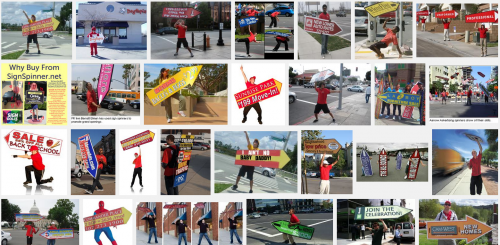In the midst of the recession a new occupation emerged: the sign spinner. These individuals stood on sidewalks outside of businesses, dancing with signs or arrows that they threw and twisted in the air and around their bodies. Some of them were pretty cool, actually.
Yesterday NPR discussed the replacement of some of these spinners with mannequins. Robots that are programmed to spin the sign. Of course, they aren’t nearly as good as a halfway decent human sign spinner. But, it was argued, they’re getting the job done.
From human to machine, then. But no one commented on the bizarre race- and sex-change that accompanied this shift. In my part of the country, most human sign spinners are black or Latino men. I suspect that’s true wherever there’s a substantial non-white, non-Asian population. But the mannequins appear to be overwhelming white women.
The Google image search for each somewhat supports this narrative. The mannequins are overly white women and the humans are almost all men and, arguably, disproportionately men of color.
Google search for “sign spinners” (click to enlarge):
Google search for “‘mannequin sign spinners” (click to enlarge):
Isn’t. This. Interesting.
When the business owner or manager can make choices about what race and gender they prefer, they choose white females. Presumably because “sex sells,” the female body (in a bikini) is the universal symbol for sex, and white women are the most valuable commodity in that market.
When we’re hiring low wage human workers, however, business owners and managers have less control over the race and gender composition of their workforce. It appears most would prefer to hire white women in bikinis for everything but, because of institutionalized racism and the sex segregation of occupations, they get men and, perhaps, men of color.
How amazing that something so simple — the evolution of the sign spinner — can tell us so much about who we value and why.
Here’s a commercial for the new robotic sign spinners, to drive the point home:
Cross-posted at Racialicious and Pacific Standard.
Lisa Wade, PhD is an Associate Professor at Tulane University. She is the author of American Hookup, a book about college sexual culture; a textbook about gender; and a forthcoming introductory text: Terrible Magnificent Sociology. You can follow her on Twitter and Instagram.


Comments 29
onewoman — October 18, 2013
It is also possible that there are many more mannequins of slim white young females than any other sort (esp. older non-white men) available on the market so it could also be cheaper to use those!
Larry Charles Wilson — October 18, 2013
Replacing real individuals with robots is inexcusable. It takes away from the jobs available for those that need them, even if they don't pay all that much.
nowlo — October 18, 2013
Awesome post about something most people probably haven't noticed (I was unaware that robot mannequin sign spinners were a thing). And that video is creepy as hell.
liz — October 18, 2013
"But no one commented on the bizarre race- and sex-change that accompanied this shift."
the NPR article you cited in the paragraph prior to the one containing this sentence did. i like this blog and the insight it can provide, but sometimes it feels like the authors are so immersed in discovering and emphasizing inequalities like this that they don't realize other people are pointing them out, too. we should all be working together for a more equal playing field for everyone.
Urgh2012 — October 18, 2013
"[N]o one commented on the bizarre race- and sex-change that accompanied this shift." - this SocImages article
"Bides says if a robot does take his job, he's not worried about finding another one. His only real quibble with the mannequins is that they all seem to be white. He requests equal opportunity for Latina mannequins, too." - the NPR article that was linked 4 sentences prior
Did you read your source at all? It was the last paragraph and you could have put "few"
Alize — October 18, 2013
I feel like the really disturbing thing is not that human sign spinners are being replaced by robots, but that so many human beings have been reduced to doing this to keep themselves fed in the first place.
I think of the scene from the first season of Breaking Bad, where young drug dealer Jesse, trying briefly to go straight, applies for a job at a bank...he's dressed in a suit and tie, he has his resume, he's trying his best to talk himself up, when the manager reveals that the position actually involves dancing around in a giant goofy dollar bill costume, spinning a sign. No wonder selling meth seemed more attractive.
Alyssa — October 20, 2013
The Google image search picture is disturbing me more for the one mannequin that is black (top row 5th in) Not only are her breasts at least the size of her head, and she's wearing a crop top, but her nipples are closer to her shoulders than where I would expect to actually see them. WTH?
Taylor — October 21, 2013
Is it possible that sign spinning mannequins, being an evolution of regular mannequins, are just most frequently made as white women? The store owners are likely not "choosing" between a wide variety of skin colors and genders and are instead choosing the only mannequins available for sale.
The Curious Evolution of the Sign Spinner — December 23, 2013
[…] post originally appeared on Sociological Images, a Pacific Standard partner […]
The Curious Evolution of the Sign Spinner - Pacific Standard: The Science of Society — March 25, 2014
[…] post originally appeared on Sociological Images, a Pacific Standard partner […]
Arnold — February 28, 2015
Thank you for sharing this kind of information about sign spinners, well everyone have different kind of idea but the only point here is how sign spinners value their work and how they can handle it. It is easy to say the word but its hard to do because many people now keep judging other people for what they are doing.Order for Article Spinning